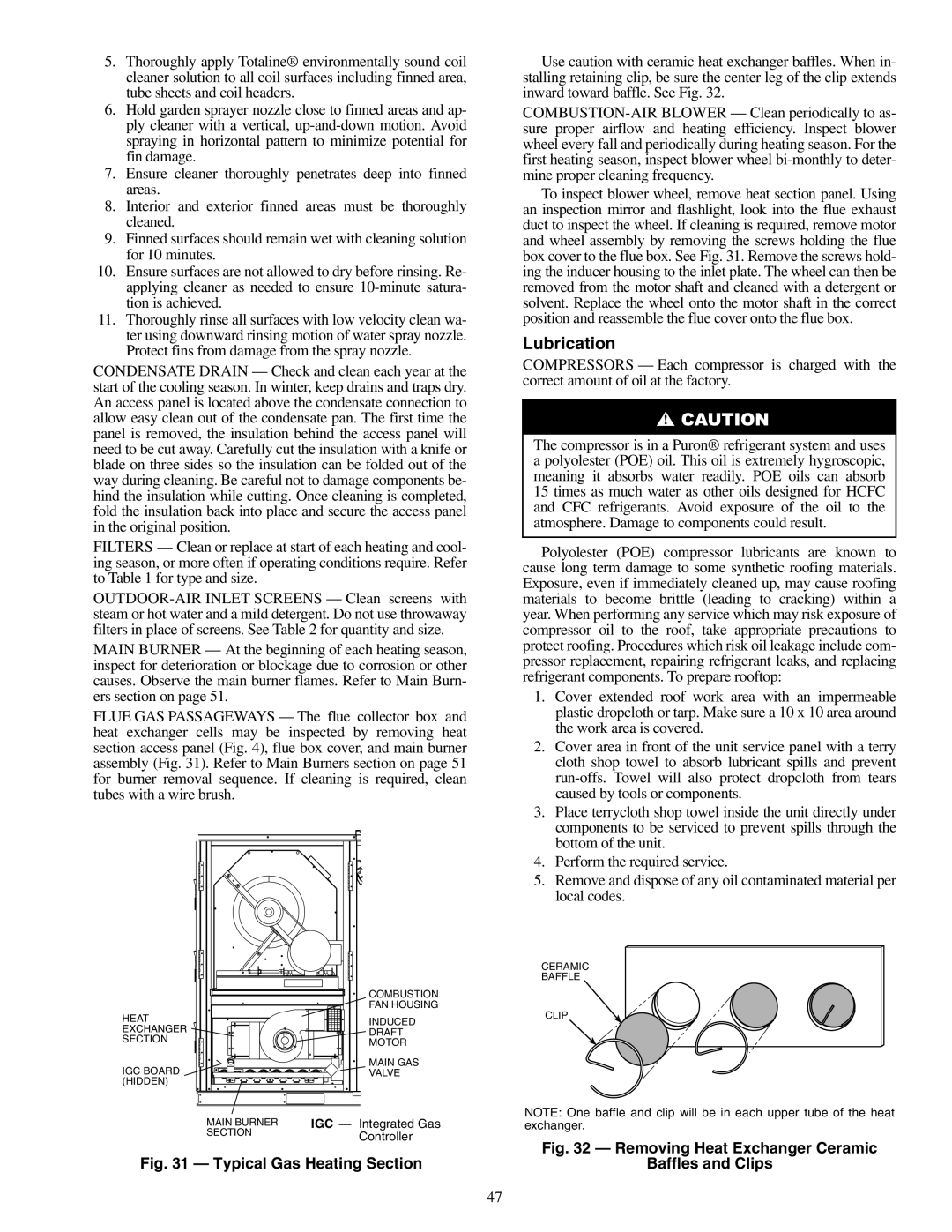
5.Thoroughly apply Totaline® environmentally sound coil cleaner solution to all coil surfaces including finned area, tube sheets and coil headers.
6.Hold garden sprayer nozzle close to finned areas and ap- ply cleaner with a vertical,
7.Ensure cleaner thoroughly penetrates deep into finned areas.
8.Interior and exterior finned areas must be thoroughly cleaned.
9.Finned surfaces should remain wet with cleaning solution for 10 minutes.
10.Ensure surfaces are not allowed to dry before rinsing. Re- applying cleaner as needed to ensure
11.Thoroughly rinse all surfaces with low velocity clean wa- ter using downward rinsing motion of water spray nozzle. Protect fins from damage from the spray nozzle.
CONDENSATE DRAIN — Check and clean each year at the start of the cooling season. In winter, keep drains and traps dry. An access panel is located above the condensate connection to allow easy clean out of the condensate pan. The first time the panel is removed, the insulation behind the access panel will need to be cut away. Carefully cut the insulation with a knife or blade on three sides so the insulation can be folded out of the way during cleaning. Be careful not to damage components be- hind the insulation while cutting. Once cleaning is completed, fold the insulation back into place and secure the access panel in the original position.
FILTERS — Clean or replace at start of each heating and cool- ing season, or more often if operating conditions require. Refer to Table 1 for type and size.
MAIN BURNER — At the beginning of each heating season, inspect for deterioration or blockage due to corrosion or other causes. Observe the main burner flames. Refer to Main Burn- ers section on page 51.
FLUE GAS PASSAGEWAYS — The flue collector box and heat exchanger cells may be inspected by removing heat section access panel (Fig. 4), flue box cover, and main burner assembly (Fig. 31). Refer to Main Burners section on page 51 for burner removal sequence. If cleaning is required, clean tubes with a wire brush.
Use caution with ceramic heat exchanger baffles. When in- stalling retaining clip, be sure the center leg of the clip extends inward toward baffle. See Fig. 32.
To inspect blower wheel, remove heat section panel. Using an inspection mirror and flashlight, look into the flue exhaust duct to inspect the wheel. If cleaning is required, remove motor and wheel assembly by removing the screws holding the flue box cover to the flue box. See Fig. 31. Remove the screws hold- ing the inducer housing to the inlet plate. The wheel can then be removed from the motor shaft and cleaned with a detergent or solvent. Replace the wheel onto the motor shaft in the correct position and reassemble the flue cover onto the flue box.
Lubrication
COMPRESSORS — Each compressor is charged with the correct amount of oil at the factory.
The compressor is in a Puron® refrigerant system and uses a polyolester (POE) oil. This oil is extremely hygroscopic, meaning it absorbs water readily. POE oils can absorb 15 times as much water as other oils designed for HCFC and CFC refrigerants. Avoid exposure of the oil to the atmosphere. Damage to components could result.
Polyolester (POE) compressor lubricants are known to cause long term damage to some synthetic roofing materials. Exposure, even if immediately cleaned up, may cause roofing materials to become brittle (leading to cracking) within a year. When performing any service which may risk exposure of compressor oil to the roof, take appropriate precautions to protect roofing. Procedures which risk oil leakage include com- pressor replacement, repairing refrigerant leaks, and replacing refrigerant components. To prepare rooftop:
1.Cover extended roof work area with an impermeable plastic dropcloth or tarp. Make sure a 10 x 10 area around the work area is covered.
2.Cover area in front of the unit service panel with a terry cloth shop towel to absorb lubricant spills and prevent
3.Place terrycloth shop towel inside the unit directly under components to be serviced to prevent spills through the bottom of the unit.
4.Perform the required service.
5.Remove and dispose of any oil contaminated material per local codes.
CERAMIC
BAFFLE
HEAT EXCHANGER SECTION
IGC BOARD (HIDDEN)
COMBUSTION
FAN HOUSING
INDUCED
DRAFT
MOTOR
MAIN GAS
VALVE
MAIN BURNER | IGC — Integrated Gas |
SECTION | Controller |
CLIP
NOTE: One baffle and clip will be in each upper tube of the heat exchanger.
Fig. 32 — Removing Heat Exchanger Ceramic
Fig. 31 — Typical Gas Heating Section
Baffles and Clips
47
